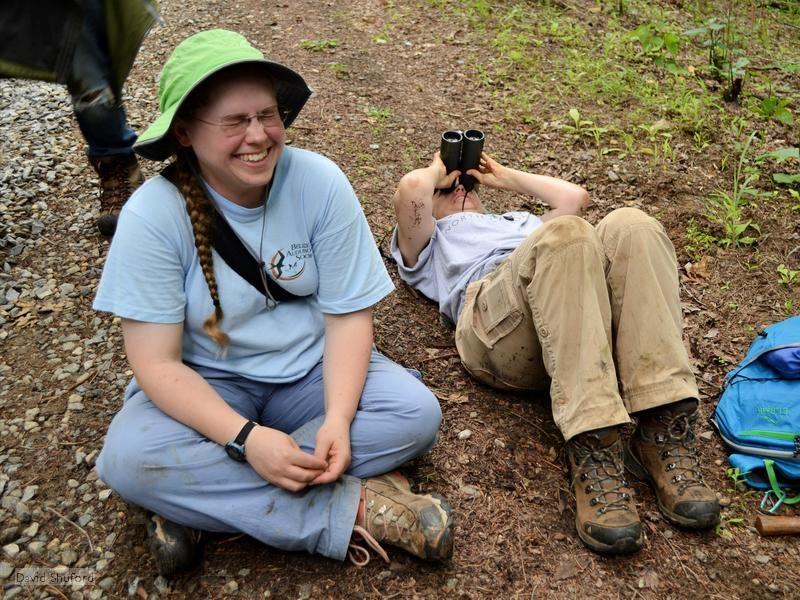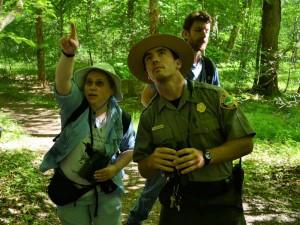Audubon North Carolina has 10 amazing chapters across the state who help put a local focus on bird preservation and conservation issues. In this special blog series, we’ll focus on a chapter each month to learn more about their history, what they are working on, and to increase the statewide understanding of special ecosystems and habitats. Each month will include a series of posts about each chapter including a post from our biologists that will share a unique research project that is happening in the chapter’s geographic footprint.
This month’s chapter is Forsyth Audubon in Winston-Salem. Please welcome guest writer Katherine Thorington
It began with eager chapter members, two field biologists (myself and Kim Brand) and a park with lots of human history and natural history data. The Forsyth Audubon breeding bird census of Historic Bethabara Park started in spring 2009 with a goal: capture a baseline “snapshot” of bird species breeding in the Park, and do it in such a way that the study could be replicated by Audubon volunteers in the future.
The study would document changes associated with human land-use, invasive species and climate change.
Bethabara means “house of passage” and is the location of the original 1753 Moravian settlement in North Carolina. Our results are a published scientific paper in Southeastern Naturalist and Audubon citizen scientists who are actively involved in research and conservation.
The Park is a favorite with birders because it is one of the best and most diverse places within Winston-Salem to see migrants and resident species including Blue-winged Warblers, Brown-headed Nuthatches and Barred Owls. The Park and similar greenspace patches located in urban and suburban areas provide important resources for birds and may be crucial for breeding success and individual survival as habitats and climate change.

THE STUDY IN QUESTION:
We trained 12 experienced birders from Forsyth Audubon in standard territory mapping methods and conducted weekly surveys of the park April–July 2009 and 2010. Birders recorded all birds they saw and/or heard during these surveys on the Park maps, and then Kim and I took their data to assess the breeding bird community, archiving our observations in eBird.
We saw or heard 109 bird species--60 for which we documented breeding territories. The breeding community was split between migrants (32 species) and residents (34 species) and included 3 exotic species.
Some species are particularly hard to detect while others are particularly apparent—in 2010, birders on a Carolina Bird Club field trip found a rarity in a Ruby-throated Hummingbird nest that signified a territory not found by our census efforts. Northern Cardinals, on the other hand, are hard to miss! In 2009, we found 69 territories and 5 nests, and in 2010, we found 89 territories and 2 nests.

NEW TERRORITIES:
We documented territories for 10 woodland interior species including Wood Thrush, Ovenbird and Scarlet Tanager. Partners in Flight designates two of these birds—the Wood Thrush and Brown-headed Nuthatch—as US birds of conservation concern. Eight other documented species qualify as Piedmont species of conservation concern during the breeding season; three of these are common species in steep decline: Chimney Swift, Belted Kingfisher and Northern Flicker.
As expected, Brown-headed Nuthatch territories were concentrated in habitats with access to pines. All observed territories were within 125m of a pine stand. However, three of the four known nest locations—those on the wetlands—were in snags standing in permanent water.
NEW PROJECTS FOR FORSYTH:
Six volunteers led a pilot study of nesting Wood Thrush in 2009 and found nine Wood Thrush nests and 21 territories. In 2010, when we were not actively looking for nests, we found 18 territories and one nest.
Territory density and locations were similar between years, but the Wood Thrush population will face increasing pressure as urbanization around the park increases. Because of these observations and Forsyth Audubon members’ passion for Wood Thrush, we are collaborating with Audubon International Alliances, Audubon North Carolina and the Smithsonian Migratory Bird Center on a migratory connectivity study.
In 2014, we put GPS backpacks on 22 Wood Thrushes at Bethabara and at Pilot Mountain State Park Yadkin River Section, and in May 2015 we began recapturing them to find out exactly where they spent the winter, how they got there and how they got back.
A big thank you to all of our participants! Citizen science does so much to document the changes we see in urban and suburban bird populations. Also a special thanks goes out to Ellen Kutcher, then executive director of Historic Bethabara Park, and the rest of the park staff, for letting us conduct this research and continue the Wood Thrush research within the Park!



